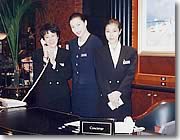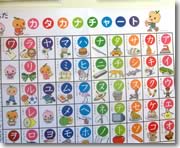●Sculpting a bilingual identity ? Another look back
At some point, we all come upon a fork in the road of life. My first such “fork” appeared at age sixteen, when I was dealt with the choice to either stay in Japan for college or go to the U.S. I was lucky that my parents were willing to send me to college, but the decision was grueling, nonetheless.

ウェスティン東京でコンシェルジュのアルバイトをしてた頃。話し方から正しいおじぎまで、あらゆる礼儀作法を教わった。 |
Most international school students graduate U.S.-bound (about 80 percent), and the rest either enter Japanese universities, or venture on to Europe, Canada, or back to their native countries. In my case, my brother was in the east coast, and as far as my citizenship goes I’m an American as much as I’m Japanese, so the natural choice was to apply to schools in the U.S.
But before I could take the path, I was stopped short by my brother’s sudden death. Back to the beginning, I stared at the fork and asked: “Do I stay or do I go?”
On the one hand, I didn’t want to leave my mother behind. But neither did I have a burning desire to leave the comfort of being where I new who I was, where I wouldn’t get lost in the crowd, or get lost in my own quest to find my identity. It was, however, painfully clear that my English was way sub-par to the expectation of my dad, an English professor. He tore through a draft of my college application essay, which was returned to me with barely an untouched sentence. I couldn’t convince myself any longer that “chuto-hanpa” ? or middle-of-the-road ? was acceptable. I had to go. |

ワイキキをドライブ中、「ヌードショーってなーに?」と娘に聞かれた。「読めてる! スゴイ」とハパママ感激。これもれっきとしたカナの復習? |
Over the next four years, my English was stripped, waxed, torn apart, and put back together. So was my identity (as is expected for a girl in her salad days). But I stubbornly stuck to my Japanese roots and hung out as much as possible at Japanese stores and restaurants (slim pickings in Chicago) ? any exposure to Japanese language as possible. I sought out Japanese-looking people and struck random conversation with them, hoping that even once out of ten, I’d meet a fellow expatriate with a similar longing to “stay connected.”
One experience that changed me for good was actually a summer spent back home, an internship at The Westin hotel in Tokyo. I could’ve lived without the lessons in bowing, but the professional training I received was for me, a feat of a lifetime.
A 19-year-old without real work experience in Japan, my stint in the service industry was just the pill to boost my grasp (and appreciation) of the Japanese language. I understood, for example, the simple difference between “ohayo” and “ohayo gozaimasu” (whereas in English “good morning” is just as suitable for royalty as it is to your average Joe). Obvious. Piece of cake. But through serving guests, and watching and listening to my graceful hotelier colleagues, I learned the respectful intonation behind “sayoudegozaimasuka” instead of “soudesuka,” and the subtle variance between “kudaisaimase” and “kudasai.” The hotel experience was like finishing school for me; a crash course in polishing my manners, breaking bad habits and adapting to a more refined tongue I’d only heard around me, but had never used myself. |
| But as I’d suspected, English took over as my native language in the years following. Reading newspapers and working in Japan preserved some ability to read and speak, but years of not writing forged a huge gap between my English and Japanese. Without the Internet, I couldn’t even write a thank you letter today without insulting someone. |

ハワイでのびのびと育つバイリンガル・キッズよ、どうか「中途半端」を克服してくれ! |
Bottom line, the road to bilinguality is arduous and painstakingly humbling. And it’s so easy to mess up Japanese, this delicate language riddled with so much formality. So when I listen to my daughter and her chanpon Japanese, I wonder to myself if she’ll ever attain what I haven’t. The choice will ultimately be hers, whether at some point in her life she finds the desire to rediscover her Japanese roots. At the rate she’s going, English will continue to be her forte, and it will stay that way. The other choice is for us to move to Japan, which isn’t out of the question, considering how important I think it is for her to “live the language” in order for her Japanese to have any staying power at all.
In the meantime, we’re just grateful to be here in Hawaii, where there are countless other kids and parents going through similar experiences and making the same difficult choices. Sure, it helps that if you threw a mango, you’d hit someone who spoke Japanese. But more importantly the beauty of raising bilingual kids in Hawaii is that you have other people to bounce off your ideas and concerns, and if anything, with whom you can commiserate. |
|
| 日本語要約 |
| ●最終回 頑張れ! ハワイのバイリンガル・キッズ
人生の分かれ道って、ありますよね? そんな道と初めて向かい合ったのは16の時でした。日本のインターナショナル・スクールの卒業生は大抵アメリカか日本の大学に進むか、母国に帰るケースがほとんどなのですが、私は多数派に従って渡米するつもりでした。でもその選択もなかなか定着せず、「やっぱり日本に居ようかな?」とか「アメリカに行って自己喪失したらヤダな」と悩んでました。
ぐずぐず悩んでいる内に起こった兄の事故死。またもやふりだしへ戻り、母を置いてアメリカに行くか、日本に残るか、迷わされました。ちょうどその頃、一応アメリカの大学願書を準備していて、その為のエッセイが父の手に渡りました。「お前の英語は標準以下だぞ」と言われ、オリジナルが読めないほど訂正されてしまいました。このままではまずい。これをきっかけに、思い切ってアメリカ行きを選んだのです。
大学に行くと案の定、英語は赤裸にされ解体され、一から直されました。未熟な17歳、アイデンティティ・クライシスも最もの事。でも日本人としてのルーツにはやけにしがみつきたくて、(シカゴに数少ない)日本のスーパーや本屋さんでよく時間を潰したものです。
そもそも、日本の実社会でマナーや言葉遣いを身につけないまま日本を発ってしまった私の日本語は、まだ「中途半端」を脱出できず、ぶっきらぼうでさえありました。そんな私にいくらか磨きをかけてくれたのがある夏の経験、東京のホテルでのアルバイトでした。「そうですか」と「さようでございますか」が合体して「そうでございますか」と言ってしまったり、敬語と尊敬語と丁寧語の微妙な差を把握するまでに何度も失言を繰り返し、お客様の前で恥をかいては先輩達に直され… でも、「洗練されたい!」という気持ちは強く、またその悔しさが日本人としての誇りだったのだと今では思えます。
しかし再びアメリカに戻って年月が経つにすれ、英語は確かに母国語と変わって行き、日ごろの努力で日本語を完全に忘れることは無かったものの、書面では英語とのギャップはおのずと開いていきました。最近では、日本語で簡素な手紙を書くにもインターネットに頼ってしまってます。
要は、バイリンガルとは恥と失敗を繰り返して歩む長くしぶとい道のりなのです。特にデリケートで礼儀深く、ちょっとした言い損ないでも誤解(または大笑い)を招く日本語。今ちゃんぽんでしか話せない娘が果たしてマスターできるのか? 正直言って心配です。塾、補習校、まんが、進研ゼミ等、親として与えてあげられる物は全部与え、その上でバイリンガルを追求するかどうかは彼女が自身で決めること。いずれは日本へ行き、向こうで生活をしながら、もっと自然な日本語を身につけてくれる事を望むばかりです。
こんなに悩んでもしょうがないのかもしれませんが、同じく頭を抱えて考えている親が結構多いのが、(私にとって)ハワイの良いところ。「なるようになるんじゃん?」と言われてしまえばそれっきりだけれど、「そうよね〜」と一緒に悩んでいる日本人ママ達がたくさんいてくれるハワイは、バイリンガルの子育てをするママには、とても心強い場所だと思います。子供にネイティブな英語を学んでもらいたい反面、日本人としての意識と言語力も失ってもらいたくない、という葛藤と向き合う毎日。
自分と似た「究極の選択」を迫られるであろう彼等の将来を心配する一方、結果はともあれ、ハワイの美しい自然の中でのびのびと成長できるのは、とてもラッキーだと思うし、2つの国をバックグラウンドに持つ、多くのバイリンガル・キッズに囲まれて育ってくれて、「本当にうれしいな〜」、と思う今日この頃のハパママです! |
|
|
コメントを残す